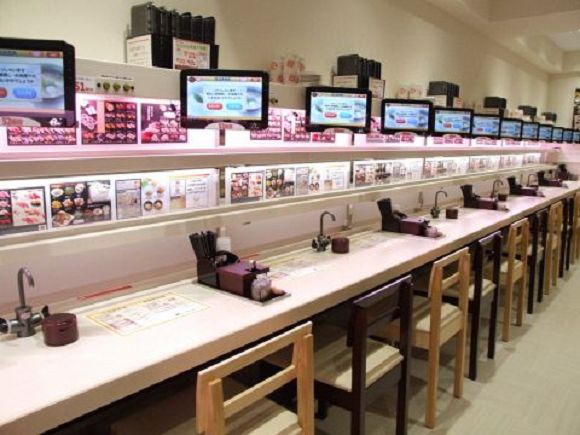Kaitenzushi restaurants have come a long way. In the beginning, their system of having diners grab their own plates of sushi from a revolving conveyor belt was seen as a quirky technological novelty, or by more severe critics as a sub-par tarnishing of the proper sushi-eating experience.
Since then, though, kaitenzushi has become one of the most broadly beloved sectors of the Japanese restaurant industry, having grown so popular that certain operators are experimenting with unique new kaitenzushi niches. Now, one company is planning to take its revolving sushi restaurants into a bold new direction by revamping them so that the sushi doesn’t revolve.
Kaitenzushi chain Genki Sushi currently has about 130 branches across Japan. But while kaitenzushi literally means “revolving sushi,” the company has been steadily moving away from the orthodox kaitenzushi delivery system.
Until recently, the standard way to run a kaitenzushi restaurant was to have a staff of sushi chefs preparing morsels of rice and fish in large batches, then putting them on the conveyor for customers to grab as they please. However, if there’s a lull in the flow of diners, some of that sushi will be going around and around long enough to lose some of its freshness. Not enough to be a health concern, but enough to dry out and negatively impact the flavor and texture.
Because of this, the restaurant staff will periodically remove plates of sushi that have been on the conveyor too long and dump them in the trash. Still, drawing the line for when to remove sushi from circulation isn’t an exact science, and the surest way for customers to ensure their sushi is fresh and tasty is to not even bother with taking a plate off the conveyor and instead just ask for their sushi to be made to order, which is always an option at kaitenzushi restaurants. Many establishments now have tableside tablets that customers can use to order with just a few taps of their finger. The sushi is prepared in the kitchen and placed on a plate, and the plate is then in turn placed on a rail that quickly slides the order to the customer.
Genki Sushi says that these direct tablet orders now account for roughly 80 percent of the sushi consumed by its patrons in branches that have such a system. In response, obviously the chain now places fewer plates of sushi on the conveyor, but even still, a spokesperson for the company says that it throws out an amount of uneaten sushi equivalent to about five percent of its sales. Given that the average annual revenue of a Genki Sushi location is 178 million yen, that means that each branch is wasting some 8.9 million yen every year. Multiply that out by 130 Genki Sushi restaurants, and the total cost is over 1.1 billion yen.
The new direct-order format is seen as a way to eliminate that waste, and its working out so well for Genki Sushi that 30 Genki Sushi restaurants now have no revolving conveyor belt at all, and the company is planning to convert all of its locations to a non-revolving system within the next five years. Meanwhile, many are expecting rival chain Kappazushi, one of the giants of the industry with around 340 branches, to follow suit in order to cut costs and remain competitive. So while this may mean diners will have to come up with a new name for kaitenzushi, since it won’t kaiten (“revolve”) anymore, if the result is fresher sushi for customers, higher profits for restaurants, and less waste of food and electricity, we don’t think too many people will be complaining.
Source: Shupure News
Read more stories from RocketNews24. -- Customers’ Behaviour Changing Sushi Culture in Japan -- Enjoy revolving sushi at home (even if the catch of the day comes with a catch) -- What to expect from conveyor belt sushi restaurants: not necessarily fish
© Japan Today Take our user survey and make your voice heard.
Take our user survey and make your voice heard.




4 Comments
Login to comment
nath
Eventually we'll come full circle--ordering from a sushi chef who'll make the sushi right in front of us.
Scrote
If it comes on a track, how about senro sushi 線路寿司?
Seawolf
Always loved Kappa Sushi for their "Shinkansen"speed rail above the conveyor for orders with announcement of arrival, than stopping right in front of you, and am all for this, usually grab only the first plates from the belt, the rest is ordered from the screen, kids plates anyway without wasabi, never from the belt. And those morsels are made by a machine, not by hand (which would actually make it more clean, right?), but thats totally fine with me.
gabrial888
What does this mean for Ishikawa prefecture companies that produce virtually 100% of these sushi conveyers? I hope they produce the sushi rail system as well. Otherwise, if this conveyer-less trend takes hold, they are goners. https://en.wikipedia.org/wiki/Conveyor_belt_sushi
I also feel a bit sorry for the employees there as they must work harder and harder to cater to individual needs for a measly price of 108 yen per plate. I heard these sushi restaurants' ingredient cost portion is a lot higher than other restaurant business categories. Hopefully the reduced cost from dispensing with conveyers and smaller waste will contribute to higher salaries for employees, but I'm skeptical.